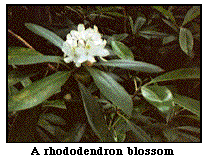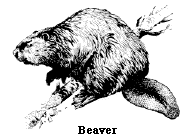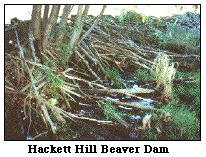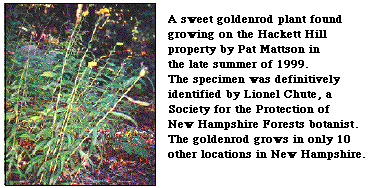According to information provided at a SEPTEMBER 30, 1998 PUBLIC HEARING (a special meeting of the Board of Mayor and Aldermen), Manchester city officials had made plans to purchase and develop a significant portion of the Hackett Hill property, and to provide "protection" for only limited sections. Their stated goal was to "increase the tax base of the city" by the construction of an industrial park on the property. Although the specific areas designated for development and for "protection" were still to be finalized , clearly development at any point on the property would be hurtful to the environment.
 Instead of being
used for any type of development, the nature of the property is such
that it deserves protection following a biodiversity approach . This
approach recognizes that there is a wide array of species present on
earth, and it is the moral obligation of humans to maintain this
richness of species, as opposed to diminishing it. Certain species are already low in numbers
, either in a given area, or world-wide, while others, amphibia in
particular, appear to be undergoing a serious decline. These are the
species which are most "at risk" for becoming extinct or extirpated
(becoming locally extinct), thus decreasing biodiversity.
Instead of being
used for any type of development, the nature of the property is such
that it deserves protection following a biodiversity approach . This
approach recognizes that there is a wide array of species present on
earth, and it is the moral obligation of humans to maintain this
richness of species, as opposed to diminishing it. Certain species are already low in numbers
, either in a given area, or world-wide, while others, amphibia in
particular, appear to be undergoing a serious decline. These are the
species which are most "at risk" for becoming extinct or extirpated
(becoming locally extinct), thus decreasing biodiversity.
The Natural Heritage Inventory of New Hampshire has listed three plant species on the Hackett Hill property that are of concern because of their rarity. The giant rhododendron (Rhododendron maximum), the swamp azalea (Rhododendron viscosum) and the sweet goldenrod (Solidago odora) are recognized as "threatened" species within the state. Hessel's Hairstreak butterfly (Mitouri hesseli) is on the NH endangered species list.
The giant rhododenrons and swamp azaleas are for the most part located within the Atlantic white cedar and black gum swamps. Importantly, Atlantic white cedars themselves are presently considered rare and in need of protection. They exist in a limited number of places in the eastern US and Canada, and their numbers have been declining. Black gum trees are found in a greater number of regions, but the age of the trees in the Hackett Hill swamps is highly unusual. It is generally agreed that the swamps, as "natural communities", should be protected from any threats which might destroy their integrity, but to do so is not a simple matter.
 The swamp-located
species have lived in the Hackett Hill area for lengthy periods of
time, in a nearly-undisturbed condition. They have undoubtably
established a complex network of relationships with each other
regarding food, space, reproduction, etc., generally referred to as
"the balance of nature". One well known example is the dependency of
the endangered Hessel's Hairstreak butterfly* not only on the
Atlantic white cedars for a stage in its reproductive cycle, but also
on other more common plants in the cedar swamps for a food supply.
However it is a certainty that there are many other similar
relationships within the swamps.
The swamp-located
species have lived in the Hackett Hill area for lengthy periods of
time, in a nearly-undisturbed condition. They have undoubtably
established a complex network of relationships with each other
regarding food, space, reproduction, etc., generally referred to as
"the balance of nature". One well known example is the dependency of
the endangered Hessel's Hairstreak butterfly* not only on the
Atlantic white cedars for a stage in its reproductive cycle, but also
on other more common plants in the cedar swamps for a food supply.
However it is a certainty that there are many other similar
relationships within the swamps.
Development can be considered as a serious threat to these various interactions, and could thereby destroy the integrity of the swamp communities. This catastrophe could occur either directly or indirectly.
The most direct impact of development on the Atlantic white cedar swamps and the black gum swamps would be if building were to occur in association with the aged "infrastructure" which has already defiled the property. The location of these paved areas is in extremely close proximity to several of the larger swamps. The water in all of the swamps is characteristically acidic and low in nutrients, and life forms found in these "natural communities" have adapted to these unusual conditions. Any "runoff" from development that would change the water acidity, or add nutrients to the water, is likely eventually to cause the demise of many of the swamp-dwelling life forms. Furthermore, the life forms are also well-adapted to natural seasonal fluctuation in water levels that occur in the swamps, and might be incapable of adapting to development-caused changes in water quantity.
It has been proposed that portions of the forested uplands at the periphery of the swamps could be designated as "buffer zones", and development prohibited here. While this approach is commonly used for protecting wetlands from the harmful effects of development, the Hackett Hill swamp communities are uncommon and extremely fragile. There is no certainty that buffer zones could protect all of the swamp inhabitants from unnatural changes in water quality or quantity.
Development may also cause effects on the biodiversity of swamp communities which are indirect. Importantly, the swamps merge gradually with the surrounding forested uplands. Some of the species which live at one season or another within the swamps characteristically migrate in and out of these communities to forage for food, to undergo changes in their development from a juvenile to an adult form, or to hibernate. These behavior patterns may be interrupted when members of the migratory species encounter developed areas. Eventually a serious decline in the size of certain animal populations could result. The red-spotted salamander, or newt, is an animal of this type, and an instance where the "phantom parking lots" of Hackett Hill nearly caused the demise of a newt has been documented. (click here for details)
Another indirect effect of development on the biodiversity of swamp communities deals with potential effects of construction activities on vernal pools. These pools are classified as wetlands since they consist of depressions where spring runoff or snow melt water collects in the spring. Later on, during the summer, the pools are nearly dry. They appear as slight depressions in the landscape that could easily be considered inconsequential by developers. However during the spring season, the vernal pools literally teem with life. A loss of these vernal pools, which may be located in proximity to the swamps, or elsewhere on the property, could mean a decline in the size of animal populations, some of which are swamp-related. (click here for details)
As is the case of some of the vernal pools, development at certain places on the Hackett Hill property may cause habitat loss and extirpation of rare or threatened species that is unrelated or less closely related to the swamp communities.
 Several colonies
of giant rhododendrons are located at considerable distances from the
Hackett Hill swamps, both in upland forested areas and near the open
water of Millstone Brook. Beavers that originally were located in
other areas of the property and were disturbed by development, moved
downstream near the rhododendron
Several colonies
of giant rhododendrons are located at considerable distances from the
Hackett Hill swamps, both in upland forested areas and near the open
water of Millstone Brook. Beavers that originally were located in
other areas of the property and were disturbed by development, moved
downstream near the rhododendron  colonies. There are reports that the beavers then
proceeded to destroy substantial amounts of these plants.
colonies. There are reports that the beavers then
proceeded to destroy substantial amounts of these plants.
In another location in New Hampshire, beaver dams were responsible for the flooding and destruction of a black gum swamp. Conceivably, displaced beavers could cause a similar catastrophe on Hackett Hill.
The threatened species of goldenrod (sweet goldenrod) which grows on the Hackett Hill property is found in a "wastelands" type habitat near the southwestern border of the property. It grows in limited numbers near the recently-closed Manchester city landfill. If development occurs in this area it is unlikely that much attention will be given to protection of the sweet goldenrod.
Studies done by the New Hampshire Natural Heritage Inventory indicate that the above-mentioned threats to goldenrod, as well as beaver-associated damage within and without the swamps, should be taken seriously. (click here for details).
For the above-mentioned reasons, it appears that an approach of "zero development" can best protect the species biodiversity known to exist on the Hackett Hill area, i.e., the property should remain unfragmented and/or not be surrounded by development of any type. In addition to the reasons already given, it is also possible that more endangered species may exist on the property than have currently been documented, since in Massachusetts, 34 threatened or endangered species have been discovered in "acid peatland" communities. If a policy of "zero development" is put into practice, it will protect any such Hackett Hill dwellers from extirpation, even if they have not yet been identified.
* This butterfly has not yet been identified in the Hackett Hill Atlantic white cedar swamps.
Credits: The drawing of the beaver appears on the website of the NH Fish and Game Department and the photograph of Hessel's Hairstreak butterfly can be found on The Maine Department of Inland Fisheries and Wildlife Website
PERTINENT LINK
